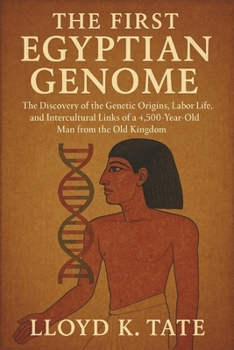The First Egyptian Genome: The Discovery of the Genetic Origins, Labor Life, and Intercultural Links of a 4,500-Year-Old Man from the Old Kingdom
The First Egyptian Genome: The Discovery of the Genetic Origins, Labor Life, and Intercultural Links of a 4,500-Year-Old Man from the Old Kingdom The First Egyptian Genome presents an examination of ancient Egyptian civilization through the lens of recent genetic and archaeological discoveries, offering readers a perspective on the lives, ancestry, and cultural achievements of one of history's most enduring societies. Drawing on DNA sequencing and excavations, this book details the connections between Egypt's earliest inhabitants and their neighbors across the Fertile Crescent, while expanding on the monumental legacy of the Old and New Kingdoms. The narrative begins with the first complete sequencing of an ancient Egyptian genome, extracted from a 4,800-year-old skeleton discovered in Nuwayrat, south of Cairo. This remarkable find reveals a complex ancestry, blending North African roots with significant contributions from Mesopotamia, shedding light on ancient migration patterns and cultural exchanges during the era of the pyramid builders. The book further examines the skeletal evidence of a potter's laborious life, whose ceremonial burial in a sealed clay pot challenges assumptions about social status in the Old Kingdom. In Luxor, the discovery of Thutmose II's tomb, a royal burial from the 18th Dynasty, provides a vivid window into the architectural and religious practices of the New Kingdom. Inscriptions linking to Queen Hatshepsut and remnants of the Book of Amduat highlight the tomb's historical significance, despite its environmental challenges due to flooding. Additional excavations in Dra'Abu El Naga uncover the tombs of prominent statesmen, revealing the societal roles and artistic traditions of the period. Through a rigorous synthesis of genetic analysis and archaeological evidence, this work traces the evolution of Egyptian society from the Early Dynastic period to the height of the New Kingdom. It details the technological advancements that enabled DNA preservation in Egypt's harsh climate, the architectural innovations of both royal and non-royal tombs, and the cultural interactions that shaped the development of the Nile Valley. Each chapter offers a meticulous exploration of these findings, providing a comprehensive understanding of how ancient Egyptians lived, worked, and connected with distant civilizations. What value does the book offer?Gain a detailed understanding of the first fully sequenced ancient Egyptian genome, revealing ancestral ties that reshape our knowledge of Egypt's origins.Discover the significance of Thutmose II's tomb and its inscriptions, offering a rare glimpse into the 18th Dynasty's royal practices and familial dynamics.Discover the innovative techniques used to extract and analyze ancient DNA, bridging the fields of archaeology and genetics to uncover hidden histories.Understand the interaction between Egypt and the Fertile Crescent, evidenced by shared technologies, trade, and genetic migration.Immerse yourself in vivid accounts of ancient Egyptian life, from the labor of a potter to the grandeur of royal burials, crafted for both scholars and enthusiasts.
ORDER A COPY NOW
ORDER A COPY NOW
Format:Paperback
Language:English
ISBN:B0FGVQ98YN
ISBN13:9798291117934
Release Date:July 2025
Publisher:Independently Published
Length:128 Pages
Weight:0.40 lbs.
Dimensions:0.3" x 6.0" x 9.0"
Related Subjects
HistoryCustomer Reviews
0 rating





